KNEE SAFETYKnee injuries are among the most feared of athletic injuries and perhaps the least understood. Knee injuries have ended many seasons, careers and, in some cases, normal lifestyles.By BFS Published: Summer 2001 When I see an athlete go down with a knee injury, two thoughts immediately cross my mind: One, the athlete or coach simply did not know how to prevent this injury or two, the athlete refused to do what (s)he was supposed to do. Sometimes nothing could have been done to prevent a certain knee injury because of the way it happened, but the majority of knee injuries to athletes are preventable. HOW TO PREVENT THE PROBLEM Injury prevention to knees depends on two factors. First, you must strengthen the muscles, tendons and ligaments surrounding the knee joint. Second, you must perform every physical action with the knee in perfect alignment. Perfect alignment must occur on the field, on the court, in the weight room, during stretching and, indeed, everywhere--even sitting in a chair. Important Tip: A great strength coach must be a great observer. This article will help you become more aware of knees and what to look for in proper alignment and when to look for it. I will highlight three main problem areas: Squats (on the upward movement, knees have a tendency to pinch in causing too much stretch on the medial collateral ligaments); Cleans (on the upward movement, knees will again pinch in or even touch); and picking up the weight (as in a Clean or Dead Lift). KNEE STRENGTHENING EXERCISES Leg Extensions (Picture 1): Leg Extensions are perhaps the most common auxiliary exercise done to strengthen the knee joint area. This exercise is extensively used in rehabilitation after injuries, but can also be use as a preventive measure. This exercise strengthens the quadricep muscles, plus the tendons which connect the quads to the knee joint area. There is also strong evidence that leg extensions will strengthen the ligaments in the knee joint. Leg Extensions also have the extra benefit of strengthening the quads. Do Leg Extensions 2-3 times per week and 2-3 sets of ten repetitions. Leg Curls (Picture 2): Leg Curls are an auxiliary exercise that strengthens the three hamstring muscles and the tendons connecting the hamstrings to the knee joint area. There is strong evidence that Leg Curls will also strengthen the ligaments in the knee joint. They also have the added benefit of helping to develop speed and jumping power. Do Leg Curls 2-3 times per week and 2-3 sets of ten repetitions. Parallel Squats (Picture 3): Parallel Squats are considered a top priority Core Lift. They were once thought by coaches and doctors to be a cause of knee injuries. The opposite is true if they are done correctly with straight alignment. Correct Parallel Squats will strengthen the muscles, tendons and ligaments which surround the knee from top to bottom. Show me a team with a lot of knee injuries and I will show you a team that does not Parallel Squat or does not Parallel Squat with straight alignment. Doing Parallel Squats is like taking out an insurance policy. Put in the correct time, effort and technique and you can practically eliminate knee injuries from you program. Squats are monumental in may areas of athletic improvement including hip, leg, speed and jumping power. You should do two squat workouts per week and since this is a Core Lift, you should vary your sets and reps. OTHER GOOD EXERCISES Lunges, Box Squats, Front Squats, Hex Bar Dead Lift, Hip Sled, Sprint Sled, Sprint Chute and many other exercises will have a positive effect in preventing knee injuries as long as they are done with the knees in straight alignment. Note: Do not use knee wraps on every set with healthy knees (Picture 4). Use them sparingly, if at all. Wrapping can reduce the development of knee ligaments and tendons. When you do wrap your knees, make sure you always wrap each knee from an outside to inside style, as this will better protect the patella. KNEE ALIGNMENT WITH THE SQUAT Correct Knee Alignment (Picture 5): Get into a squatting stance and look at the middle of each knee. If you were to drop a string straight down, where would it land? The string should land in the middle of the foot for perfect alignment as in Picture 5. During any athletic movement, including squatting, the knees should always be over the middle of the toes. There are three basic problem areas for the knees to look for when squatting: Knees Out, Knees In and Knees Forward. Knees Out (Picture 6): Squatting with the knees out will put unwanted pressure on the lateral collateral ligaments. The Knees-out problem can easily be corrected by just widening out the athlete’s stance. Widen out the stance until the knees are aligned directly over the toes. Knees In (Picture 7 & 9): This problem is quite common with women athletes and junior high age boys. When squatting, the knees in problem will surface on the way up. The knees are usually alright on the way down when squatting. The knees-in problem puts unwanted pressure on the medial collateral ligaments. The knees-in problem is more difficult to correct. The first step is to yell “knees” to the athlete while squatting. This is a signal to force the knees out over the toes. This signal may or may not work the first time. If not, the second correction technique is to lightly slap the inside of the athlete’s knee (Picture 7). This gives the athlete a kinesthetic feel of the problem. The cure usually happens after only a few light slaps. If the problem persists, then video tape the athlete squatting so that (s)he can see the problem. This will almost always do the trick. Knees Forward: Many beginning squatters will want to lift their heels off the ground and bring their knees forward as the main part of their descent pattern. This puts too much pressure on the patella area, besides being horribly ineffective. If the knees are past the tips of the toes, they are too far forward. To help correct this, use the partner system and practice squatting with the hips back and with the knees vertically as straight as possible (Picture 8). The athlete should “sit tall” and “spread the chest” with the elbows and shoulders back. The athlete will now be able to balance with the heels on the ground in a perfect parallel squat position. KNEE ALIGNMENT WITH PULLING MOVEMENTS The Power Clean requires straight knees (Picture 9): Use a “jump stance” when lifting any weight from the floor as in the Power Clean. A wider, shoulder width type stance will cause unwanted pressure to the medial collateral knee ligament. After “racking” the bar, make sure the feet come back to a “jump stance” before setting the bar back to the floor. The Dead Lift requires straight knees (Picture 10): Again, use a “jump stance” when doing a Hex Bar or straight bar Dead Lift. Do not use a shoulder width stance. The knees should always be aligned straight over the feet when picking up a weight or setting it down. Look at Picture 10. Her knees are directly over her toes. This is perfect. Never Let the knees come together as in Picture 9. The technique to correct knee problems here is the same as the Squat. First, yell “knees” to help the athlete become aware of the problem. Second, lightly tap the inside of the knee and third, use video analysis. CONCLUSION Be constantly aware of an athlete’s knees, making sure they are always aligned correctly. Most Knee injuries do not have to happen. I want straight knees when blocking, tackling, jumping, sprinting, squatting, cleaning, lifting, sitting or rebounding. In short, I want straight knees even in your sleep! |
 |
|
Picture 1 & 2 |
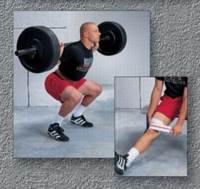 |
|
Picture 3 & 4 |
 |
|
Picture 5 |
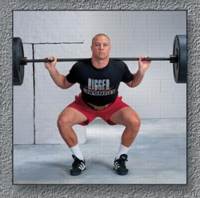 |
|
Picture 6 |
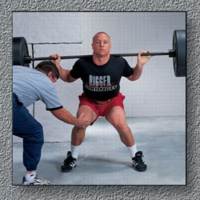 |
|
Picture 7 |
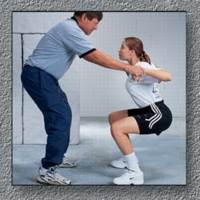 |
|
Picture 8 |
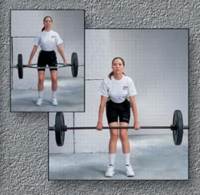 |
|
Picture 9 & 10 |